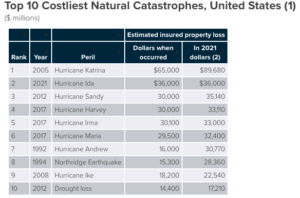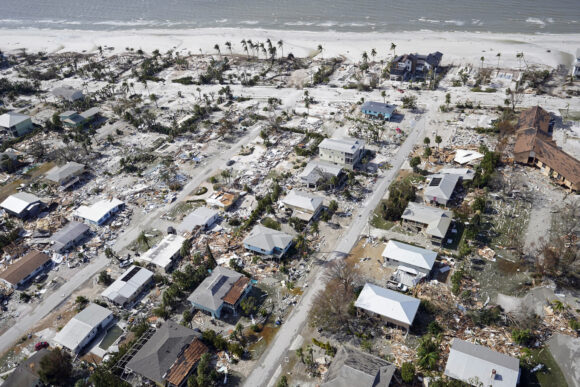Catastrophe modeler Karen Clark & Co. said Friday that Hurricane Ian will generate nearly $63 billion in losses to private insurers, which would make it the second-most expensive hurricane ever when compared to other estimates.
“Hurricane Ian will be a challenging storm for insurers due to the tremendous amount of coastal flooding and the unique nature of the Florida market with respect to a likely high proportion of litigated claims,” KCC said in “flash estimate” distributed on Friday afternoon.
Hurricane Ian made a third landfall near Georgetown, South Carolina on Friday after crossing Cuba and the Florida peninsula, where it caused unprecedented flooding from storm surge and heavy rain.
CoreLogic predicted Ian would cause $47 billion in insured losses for Florida alone. Wind damage is expected to be between $22 billion to $32 billion for residential and commercial properties. Storm-surge damage could add another $6 to $15 billion, the property data analytics company calculated.
According to the Insurance Information Institute, Hurricane Katrina in 2005 was the most costly natural catastrophe in history for insurers, with $89.7 million in losses. Several hurricanes since then have generated insured losses between $30 billion and $36 billion, including last year’s Hurricane Ida.

KCC’s loss estimate does not include payouts that will be made by the National Flood Insurance Program.
The historic damage comes after six Florida property insurers were declared insolvent. Mark Friedlander, communications director of the Insurance Information Institute, told Yahoo news last week that the financial distress wasn’t caused by hurricanes, it was spurred by the “man-made catastrophe” of an overly broad assignment-of-benefit law that encourages unscrupulous contractors to generate cash by filing insurance claims.
KCC noted that the Florida Legislature has made reforms since Hurricane Irma caused widespread damage to the state in 2017, but it did not include any discount in its damage estimate because the large number of claims that will include damage caused by both rain and water will induce more litigation. KCC said it assumes that insurers will pay some claims for damages that are not “explcitly covered.”
“The KCC estimate includes a comparable proportion of excess litigation as occurred in Hurricane Irma,” the flash report says.
KCC said Ian will be the largest loss in Florida history. The company said economic losses, which includes damage that is not insured, will top $100 billion.
Moody’s also predicted that Ian will cause “historic losses for insurers, but has not yet issued its own damage estimate.
“There are several factors that make this event unique,” the ratings house said in a press release. “This was an extremely large storm, making landfall as a very strong category 4 hurricane, bringing destructive winds, extensive storm surge along a large part of the south-west Florida coastline and severe flooding through central Florida, before its second landfall in South Carolina. We expect the settlement of claims between wind and water will take an extensive period of time to work through.”
Insurance broker GuyCarpenter issued a report on Thursday that shows why the damage caused by Hurricane Ian reached historic levels. The population of the Cape Coral/Fort Myers, Florida metropolitan area where the hurricane came ashore has grown 58% since 2010 and 1,215% since 1970. It now stands at 851,000.
Also, many of the communities in the region are built along man-made canals. Those waterways provide recreational opportunities for residents but also make it difficult for catastrophe modelers to estimate the level of damage that can be caused by storm surge.
“The complexity and prevalence of these waterways in conjunction with the fact that most regional scale storm surge models are unable to properly model the physics of flood propagation in these channels means that both pre-storm modeling of this area for planning usage as well as storm specific forecasts of this area are prone to inaccuracies,” the report says.
About the photo: This aerial photo shows damaged homes and debris in the aftermath of Hurricane Ian, Thursday, Sept. 29, 2022, in Fort Myers Beach, Fla. (AP Photo/Wilfredo Lee)
Was this article valuable?
Here are more articles you may enjoy.


 What The Return of California’s ‘Death Discount’ Means for Litigation
What The Return of California’s ‘Death Discount’ Means for Litigation  Storm Goretti Batters Europe With Violent Winds, Power Cuts
Storm Goretti Batters Europe With Violent Winds, Power Cuts  California Governor Seeks $200M to Replace EV Tax Credits Cut by Trump
California Governor Seeks $200M to Replace EV Tax Credits Cut by Trump  Musk’s xAI Faces California AG Probe Over Grok Sexual Images
Musk’s xAI Faces California AG Probe Over Grok Sexual Images 